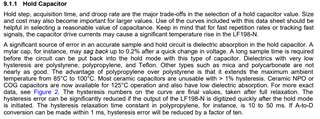Tool/software:
Hello E2E Support Forums!
This is my first time posting, let me know how to best utilize these forums.
In my design, I am using the LF398H/NOPB (same Datasheet as the LF398-N described above) as a sample and hold amplifier to hold an analog signal for ADC processing.
In our industrial application, what would be some expected worst cases that the hold capacitor could expect?
What are some capacitor parameters that would ensure the longevity of the hold capacitor?
Additional context: This is an old design in which the previous hold capacitor (Panasonic ECQP1H104GZ) has gone obsolete, and we are looking for a drop-in replacement polypropylene capacitor. I have not been able to find an alternate component that is better in all aspects. The most favorable alternate I have found is the Vishay MKP1839410251, or possibly the Vishay MKP1837410161F, however, those PP capacitors have an insulation resistance/withstand voltage that is not better than the old part, and further analysis of the application has to be done. I do not expect help with finding an alternate component, my goal is to better understand the characteristics of the LF398H to make a better guided decision.
Let me know if you need more details and thank you very much for your help!
Nicolas




